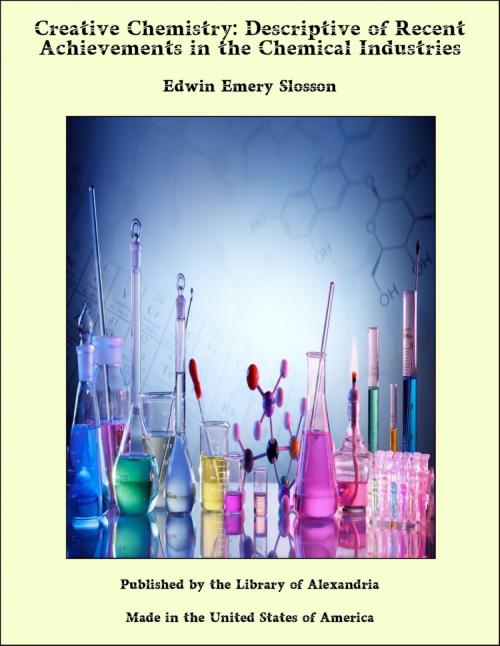Creative Chemistry: Descriptive of Recent Achievements in the Chemical Industries
Nonfiction, Religion & Spirituality, New Age, History, Fiction & Literature| Author: | Edwin Emery Slosson | ISBN: | 9781465544803 |
| Publisher: | Library of Alexandria | Publication: | March 8, 2015 |
| Imprint: | Language: | English |
| Author: | Edwin Emery Slosson |
| ISBN: | 9781465544803 |
| Publisher: | Library of Alexandria |
| Publication: | March 8, 2015 |
| Imprint: | |
| Language: | English |
The recent war as never before in the history of the world brought to the nations of the earth a realization of the vital place which the science of chemistry holds in the development of the resources of a nation. Some of the most picturesque features of this awakening reached the great public through the press. Thus, the adventurous trips of the Deutschland with its cargoes of concentrated aniline dyes, valued at millions of dollars, emphasized as no other incident our former dependence upon Germany for these products of her chemical industries. The public read, too, that her chemists saved Germany from an early disastrous defeat, both in the field of military operations and in the matter of economic supplies: unquestionably, without the tremendous expansion of her plants for the production of nitrates and ammonia from the air by the processes of Haber, Ostwald and others of her great chemists, the war would have ended in 1915, or early in 1916, from exhaustion of Germany's supplies of nitrate explosives, if not indeed from exhaustion of her food supplies as a consequence of the lack of nitrate and ammonia fertilizer for her fields. Inventions of substitutes for cotton, copper, rubber, wool and many other basic needs have been reported. These feats of chemistry, performed under the stress of dire necessity, have, no doubt, excited the wonder and interest of our public. It is far more important at this time, however, when both for war and for peace needs, the resources of our country are strained to the utmost, that the public should awaken to a clear realization of what this science of chemistry really means for mankind, to the realization that its wizardry permeates the whole life of the nation as a vitalizing, protective and constructive agent very much in the same way as our blood, coursing through our veins and arteries, carries the constructive, defensive and life-bringing materials to every organ in the body. If the layman will but understand that chemistry is the fundamental science of the transformation of matter, he will readily accept the validity of this sweeping assertion: he will realize, for instance, why exactly the same fundamental laws of the science apply to, and make possible scientific control of, such widely divergent national industries as agriculture and steel manufacturing. It governs the transformation of the salts, minerals and humus of our fields and the components of the air into corn, wheat, cotton and the innumerable other products of the soil; it governs no less the transformation of crude ores into steel and alloys, which, with the cunning born of chemical knowledge, may be given practically any conceivable quality of hardness, elasticity, toughness or strength. And exactly the same thing may be said of the hundreds of national activities that lie between the two extremes of agriculture and steel manufacture! Moreover, the domain of the science of the transformation of matter includes even life itself as its loftiest phase: from our birth to our return to dust the laws of chemistry are the controlling laws of life, health, disease and death, and the ever clearer recognition of this relation is the strongest force that is raising medicine from the uncertain realm of an art to the safer sphere of an exact science. To many scientific minds it has even become evident that those most wonderful facts of life, heredity and character, must find their final explanation in the chemical composition of the components of life producing, germinal protoplasm: mere form and shape are no longer supreme but are relegated to their proper place as the housing only of the living matter which functions chemically.
The recent war as never before in the history of the world brought to the nations of the earth a realization of the vital place which the science of chemistry holds in the development of the resources of a nation. Some of the most picturesque features of this awakening reached the great public through the press. Thus, the adventurous trips of the Deutschland with its cargoes of concentrated aniline dyes, valued at millions of dollars, emphasized as no other incident our former dependence upon Germany for these products of her chemical industries. The public read, too, that her chemists saved Germany from an early disastrous defeat, both in the field of military operations and in the matter of economic supplies: unquestionably, without the tremendous expansion of her plants for the production of nitrates and ammonia from the air by the processes of Haber, Ostwald and others of her great chemists, the war would have ended in 1915, or early in 1916, from exhaustion of Germany's supplies of nitrate explosives, if not indeed from exhaustion of her food supplies as a consequence of the lack of nitrate and ammonia fertilizer for her fields. Inventions of substitutes for cotton, copper, rubber, wool and many other basic needs have been reported. These feats of chemistry, performed under the stress of dire necessity, have, no doubt, excited the wonder and interest of our public. It is far more important at this time, however, when both for war and for peace needs, the resources of our country are strained to the utmost, that the public should awaken to a clear realization of what this science of chemistry really means for mankind, to the realization that its wizardry permeates the whole life of the nation as a vitalizing, protective and constructive agent very much in the same way as our blood, coursing through our veins and arteries, carries the constructive, defensive and life-bringing materials to every organ in the body. If the layman will but understand that chemistry is the fundamental science of the transformation of matter, he will readily accept the validity of this sweeping assertion: he will realize, for instance, why exactly the same fundamental laws of the science apply to, and make possible scientific control of, such widely divergent national industries as agriculture and steel manufacturing. It governs the transformation of the salts, minerals and humus of our fields and the components of the air into corn, wheat, cotton and the innumerable other products of the soil; it governs no less the transformation of crude ores into steel and alloys, which, with the cunning born of chemical knowledge, may be given practically any conceivable quality of hardness, elasticity, toughness or strength. And exactly the same thing may be said of the hundreds of national activities that lie between the two extremes of agriculture and steel manufacture! Moreover, the domain of the science of the transformation of matter includes even life itself as its loftiest phase: from our birth to our return to dust the laws of chemistry are the controlling laws of life, health, disease and death, and the ever clearer recognition of this relation is the strongest force that is raising medicine from the uncertain realm of an art to the safer sphere of an exact science. To many scientific minds it has even become evident that those most wonderful facts of life, heredity and character, must find their final explanation in the chemical composition of the components of life producing, germinal protoplasm: mere form and shape are no longer supreme but are relegated to their proper place as the housing only of the living matter which functions chemically.















